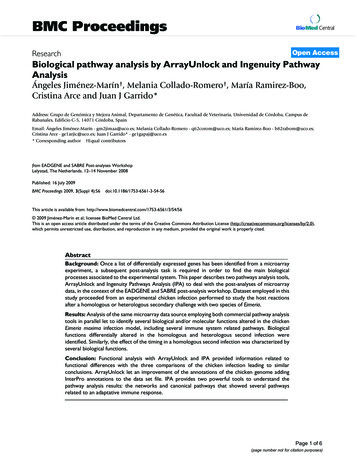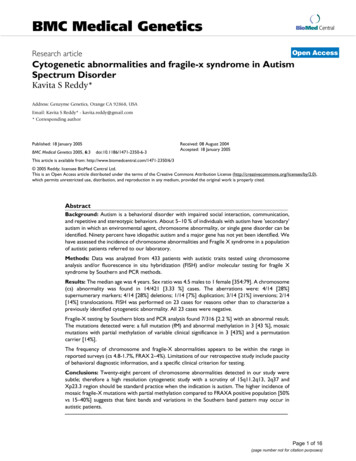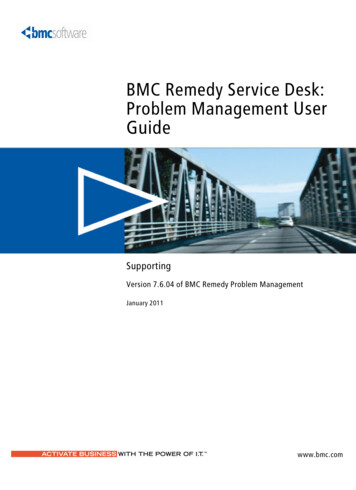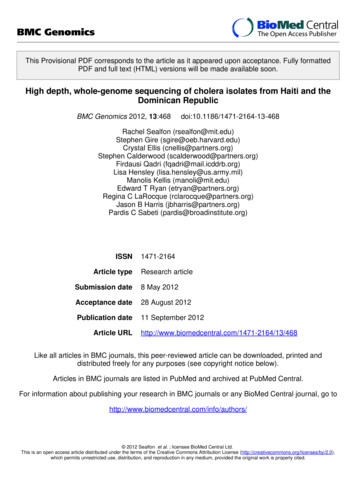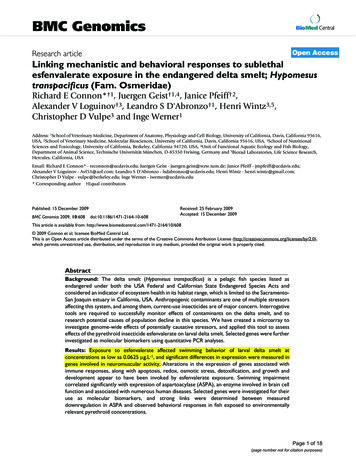
Transcription
BMC GenomicsBioMed CentralOpen AccessResearch articleLinking mechanistic and behavioral responses to sublethalesfenvalerate exposure in the endangered delta smelt; Hypomesustranspacificus (Fam. Osmeridae)Richard E Connon*†1, Juergen Geist†1,4, Janice Pfeiff†2,Alexander V Loguinov†3, Leandro S D'Abronzo†1, Henri Wintz3,5,Christopher D Vulpe3 and Inge Werner1Address: 1School of Veterinary Medicine, Department of Anatomy, Physiology and Cell Biology, University of California, Davis, California 95616,USA, 2School of Veterinary Medicine, Molecular Biosciences, University of California, Davis, California 95616, USA, 3School of NutritionalSciences and Toxicology, University of California, Berkeley, California 94720, USA, 4Unit of Functional Aquatic Ecology and Fish Biology,Department of Animal Science, Technische Universität München, D-85350 Freising, Germany and 5Biorad Laboratories, Life Science Research,Hercules, California, USAEmail: Richard E Connon* - reconnon@ucdavis.edu; Juergen Geist - juergen.geist@wzw.tum.de; Janice Pfeiff - jmpfeiff@ucdavis.edu;Alexander V Loguinov - Avl53@aol.com; Leandro S D'Abronzo - lsdabronzo@ucdavis.edu; Henri Wintz - henri.wintz@gmail.com;Christopher D Vulpe - vulpe@berkeley.edu; Inge Werner - iwerner@ucdavis.edu* Corresponding author †Equal contributorsPublished: 15 December 2009BMC Genomics 2009, 10:608doi:10.1186/1471-2164-10-608Received: 25 February 2009Accepted: 15 December 2009This article is available from: http://www.biomedcentral.com/1471-2164/10/608 2009 Connon et al; licensee BioMed Central Ltd.This is an Open Access article distributed under the terms of the Creative Commons Attribution License (http://creativecommons.org/licenses/by/2.0),which permits unrestricted use, distribution, and reproduction in any medium, provided the original work is properly cited.AbstractBackground: The delta smelt (Hypomesus transpacificus) is a pelagic fish species listed asendangered under both the USA Federal and Californian State Endangered Species Acts andconsidered an indicator of ecosystem health in its habitat range, which is limited to the SacramentoSan Joaquin estuary in California, USA. Anthropogenic contaminants are one of multiple stressorsaffecting this system, and among them, current-use insecticides are of major concern. Interrogativetools are required to successfully monitor effects of contaminants on the delta smelt, and toresearch potential causes of population decline in this species. We have created a microarray toinvestigate genome-wide effects of potentially causative stressors, and applied this tool to assesseffects of the pyrethroid insecticide esfenvalerate on larval delta smelt. Selected genes were furtherinvestigated as molecular biomarkers using quantitative PCR analyses.Results: Exposure to esfenvalerate affected swimming behavior of larval delta smelt atconcentrations as low as 0.0625 μg.L-1, and significant differences in expression were measured ingenes involved in neuromuscular activity. Alterations in the expression of genes associated withimmune responses, along with apoptosis, redox, osmotic stress, detoxification, and growth anddevelopment appear to have been invoked by esfenvalerate exposure. Swimming impairmentcorrelated significantly with expression of aspartoacylase (ASPA), an enzyme involved in brain cellfunction and associated with numerous human diseases. Selected genes were investigated for theiruse as molecular biomarkers, and strong links were determined between measureddownregulation in ASPA and observed behavioral responses in fish exposed to environmentallyrelevant pyrethroid concentrations.Page 1 of 18(page number not for citation purposes)
BMC Genomics 2009, 8Conclusions: The results of this study show that microarray technology is a useful approach inscreening for, and generation of molecular biomarkers in endangered, non-model organisms,identifying specific genes that can be directly linked with sublethal toxicological endpoints; such aschanges in expression levels of neuromuscular genes resulting in measurable swimmingimpairments. The developed microarrays were successfully applied on larval fish exposed toesfenvalerate, a known contaminant of the Sacramento-San Joaquin estuary, and has permitted theidentification of specific biomarkers which could provide insight into the factors contributing todelta smelt population decline.BackgroundThe delta smelt (Hypomesus transpacificus) is a pelagic fishspecies endemic to the Sacramento-San Joaquin estuary,whose abundance has dramatically declined since the1980s, and more precipitously in recent years [1-4]. It waslisted as endangered in 2009, under both the FederalEndangered Species Act (ESA) and California EndangeredSpecies Act (CESA). Considerable efforts are presentlybeing made to understand the causes of this recent population decline [4,5], especially because several otherpelagic species have shown similar population trends.Delta habitats have been compromised by a number ofcomplex factors, both known and unknown, potentiallyaffecting aquatic species throughout the Sacramento-SanJoaquin watersheds and estuary [4]. Pollution, in the formof chemicals contained in runoff from agricultural andurban areas, and old mining sites, treated wastewatereffluent, along with the effects of water exports, invasivespecies and habitat destruction are amongst potentialcauses for the population decline of several pelagic species[5].Identifying the sublethal impacts of environmental stressors and their mechanistic effects on resident individualsand populations is a major challenge in ecotoxicology.Contaminants may not only affect organism survival, butcan compromise ecological fitness of individual speciesvia sublethal physiological, behavioral or immunologicaleffects (e.g. [6-10]), consequently altering food web andecosystem dynamics. However, such physiological endpoints are often difficult to determine in field studies,because they either require behavioral observation andmeasurements, or because affected individuals will notsurvive in the wild. Similarly, widely used ecotoxicological tools such as standard toxicity tests [11,12] cannot easily be adapted to resident species of concern, and,conversely, it is problematic to extrapolate test resultsobtained with surrogate species to resident species of concern [13]. Recent comparative studies have demonstrateda need for identifying effects directly in the species of concern, as traditional model organisms may differ in sensitivity and physiological response to environmentalcontaminants and other stressors [14,15].Carefully selected molecular biomarkers can provide species-specific and sensitive, mechanistic information onthe overall health of an organism, as toxic responses areoften preceded by alterations in gene expression [16,17].In particular microarray gene profiling is a powerful toolfor defining genome-wide effects of environmentalchange on biological function [16,18,19]. The predictivevalue of microarrays as screening tools, as well as ourunderstanding of these responses and their application inthe field of ecotoxicology is rapidly growing. This technology can be applied in vertebrates and invertebrates,plants, algae, cell lines and unicellular organisms [20]. Inaddition, links are being established between specificmolecular biomarkers identified by microarray technology, and higher-level life history parameters, such asmetabolism, growth and reproduction [16,18,21,22].Gene expression studies carried out over short-term exposures have allowed for the prediction of chronic stressoreffects, such as reduced fecundity and embryonic arrest,somatic growth, and population dynamics [16,18,21,23].Thus, specific gene responses in studied organisms wouldnot only be indicative of health status, but when used inconservation studies, could highlight potential causes forpopulation decline. However, few biomarkers are currently understood well enough to provide conclusive evidence of contaminant impacts on aquatic species in fieldmonitoring, and extrapolating effects seen at the biomarker level to individual or population-level toxicity continues to be a challenge. For molecular biomarkers to be usedas successful monitoring tools of individual, populationand ecosystem damage, strong links need to continue tobe established between gene expression and health status.To better understand the sublethal effects of contaminantsupon H. transpacificus, and to identify biomarkers forfuture field investigations, we have constructed a microarray with 8,448 Expressed Sequence Tags (ESTs). Nogenomic information was available on any database at thetime this project began, other than a few mitochondrialsequences used in taxonomic studies [24]. We describehere, the construction and first application of this tool toidentify genes in the delta smelt, specifically respondingto exposure to esfenvalerate, a pyrethroid insecticide, andPage 2 of 18(page number not for citation purposes)
BMC Genomics 2009, 10:608present gene expression quantitation of selected biomarkers, utilizing these to explain observed swimming abnormalities. We used esfenvalerate in our study becausebiochemical responses and adverse effects on the wholeorganisms are relatively well understood [25] and therefore would aid interpretation of results in this "proof ofprinciple" test. Esfenvalerate l)-3-methylbutyrate] is a synthetic pyrethroid insecticide, widely used in agriculture,with a high risk to aquatic organisms [26]. It causes neurological damage by blocking sodium and potassiumchannels, resulting in repetitive neurological discharge[25]. In addition, pyrethroid insecticides are highly soluble in myelin sheaths of nerves, causing demyelination,resulting in conduction deficiencies through nerve lesions[27], directly affecting swimming ability, and impingingon foraging and migration. Fish are highly sensitive to thisinsecticide, with for example effects on bluegill behaviorat measured concentrations as low as 0.025 μg/L-1[28].Pyrethroids have also been reported to affect growth,induce immune responses, reduce hepatic glycogen levelsand delay spawning [9,29].The main focus of this study was not the development ofthe microarray, rather the identification of molecularbiomarkers specific to the delta smelt and stressors foundin the San Joaquin-Sacramento delta. We present hereresults from annotated genes identified through microarray analyses and specifically quantitative PCR analyses ofselected molecular biomarkers.Results and DiscussionEffects of esfenvalerate exposure: mortality and swimmingbehaviorFish larvae are known to be highly sensitive to esfenvalerate, with effects on swimming performance and enhancedsusceptibility to predation resulting from concentrationsas low as 0.0625 μg/L-1[10]. Behavior alterations are construed as being consequential to the reported neurologicalmode of action of this pesticide, further affecting foraging,migration and reproduction [30]. Toxicity of pyrethroidsin the Sacramento-San Joaquin estuary is likely alleviatedby the presence of particles and organic matter, and todate concentrations of esfenvalerate detected in the watercolumn were low, however, concentrations in winterstorm runoff from agricultural lands have been reportedup to 0.093 μg.L-1 [31], influencing our decision to investigate dose response exposures to both high and environmentally relevant concentrations in confirmatory studies.In terms of mortality, 10-d old delta smelt were onlyslightly more sensitive in this study (LC50,24 h 0.19 μg.L1) than 52-d old (LC-150,24 h 0.24 μg.L ), however swimming performance of the younger larvae was affected at aconcentration approximating one third of that 608affecting older fish (figure 1). Swimming abnormality in10-d old larvae, intensified with increasing esfenvalerateconcentration at 4 h, escalating significantly after 24 hexposure (figure 1a). This swimming abnormality wasalso concentration dependent in 52-d old fish, howeverswimming effects resulting from different time pointmeasurements differed only at the highest exposure concentration of 0.250 μg.L-1 (figure 1b), where effects onmotion increased from 22.5% anomaly at 4 h to 45% at24 h. Behavioral abnormalities, reduced food intake andgrowth, as well as increased susceptibility to predationwere reported in fathead minnow larvae exposed to esfenvalerate for 4 h to concentrations above 0.455 μg.L-1 [10].Significant swimming impairments were determined inthis study at 0.250 μg.L-1, thus delta smelt are highly sensitive to sublethal esfenvalerate exposure. Furthermore,bioaccumulation in rainbow trout have resulted in concentrations 400 times higher than background ambientlevels http://extoxnet.orst.edu.Microarray application and q-PCRThrough the application of the delta smelt microarrays,and combined analytical methods, we have identified 288ESTs, from which a number of genes of interest could beused to measure the effect of esfenvalerate and potentiallyother pyrethroid insecticides; further investigating theiruse as biomarkers in this species. Of the sequenced ESTsthat responded significantly, 118 genes were successfullyannotated; 170 matched unnamed or hypothetical proteins, or did not match the described annotation selectioncriteria; i.e. BLASTx searches resulted in expect-valuesgreater than 1 10-5 and scores below 50. Based on geneontology; molecular function, biological processes andcellular components, 94 unique genes were functionallyclassified (figure 2 and table 1) and described below.Based on the proportions of ESTs responding to successfully annotated unique genes (33%), it is estimated that ofthe 8,448 ESTs printed on the microarray, there could beabove 2,500 unique genes identified in the delta smelt.These numbers however represent responses to a singlecontaminant, and should not be construed as final asthere will have an intrinsic bias exerted upon them, however, the proportion of repeated sequences in the analyseswas very low, with a maximum of nine repetitions forCHK1 checkpoint homologue and not more than one ortwo duplication for a few others. It is also important tonote that the microarray was manufactured with incomplete genome data, thus information presented in figure 2represents proportions of a limited number of availablegenes.Differences between methods used allow for greater mining of possible biomarkers. The method by Loguinov et al[32] identified a single differentially expressed gene at0.125 μg/L-1 esfenvalerate (with no significant homol-Page 3 of 18(page number not for citation purposes)
Percentage survival and swimming normalityBMC Genomics 2009, 81004-hour Survival*80**604-hour Normal Swimming40*20a.24-hour Survival(LC50 0.19 μg.L-1)00.00*24-hour Normal Swimming***0.10(EC50 0.38 μg.L-1)0.200.300.40(EC50 0.04 μg.L-1)0.501004-hour Survival8024-hour Survival60(LC50 0.24 μg.L-1)**404-hour Normal Swimming(EC50 0.13 μg.L-1)2024-hour Normal Swimming00.00(EC50 0.11 μg.L-1)*0.100.200.300.400.50b.Esfenvalerate concentration (μg.L-1)Figure 1 behavior and mortalitySwimmingSwimming behavior and mortality. Percentage swimming normality and survival in (a.) 10-d old and (b.) 52-d old H. transpacificus exposed to esfenvalerate, standard errors (n 10). * Indicates significant reduction in survival or swimming performance compared to solvent control.ogy). The addition of LIMMA GUI analysis, also identifying this single gene, generated a broader list of genes forbiomarker selection.A large percentage of uniquely annotated genes, responding to esfenvalerate exposure; 49%, were classified asinvolved in various biological processes. These includedgenes encoding for ribosomal proteins, t-RNA synthases,telomerases, uncoupling proteins and genes involved inchromosome maintenance. Of greater interest was theidentification of genes involved in neuromuscular activity; representing 19% of identified sequences, a further12% eliciting immune responses, along with 6% relatedto oxidative stress, respiration and iron storage and 5%relevant to apoptosis. Digestion appears to have also beenaffected, along with growth and development, repre-Page 4 of 18(page number not for citation purposes)
Page 5 of 18BLASTX top hitNeuromusculartitin asmooth muscle cell-specific protein SM22 alphatoxin-1thymosin beta-12similar to 19.9 kD myosin light chain isoform 1ictacalcintropomyosinN-acylsphingosine amidohydrolasealanine-glyoxylate aminotransferasetitin balpha-2,8-polysialyltransferase IVhedgehog acyltransferase-like, aparvalbuminBTEB transcription factormyosin regulatory light chain 2similar to Clca1 se Bfish-egg lectin (FEL)procathepsin Bgamma-glutamyl hydrolasemembrane glycoproteinbeta-2 microglobulinmicrotubule-associated protein 1 light chain 3 alphamicrotubule-associated protein, RP/EB family, memberT-cell receptor beta chain ANA 11, putativeglycerophosphodiester phosphodiesterase domain containing 1CHK1 checkpoint homologApoptosistissue inhibitor of metalloproteinase 2cathepsin Hcaspase-3Species matchAccession No.ScoreE-valueConcentrationFold Change( /-)P-VALUE(or cut-off)Danio rerioEpinephelus coioidesOncorhynchus mykissLateolabrax japonicusDanio rerioIctalurus punctatusTheragra chalcogrammaTakifugu rubripesPlatichthys flesusDanio rerioOncorhynchus mykissDanio rerioCyprinus carpioPimephales promelasSalmo salarDanio rerioPerca flavescensDanio rerioABG48500ABW04145AAM21198P33248XP 7411NP 957181CAC83659ABO28528CAD89610XP 694323ABU49423NP 30.06250.00200.06250.06250.0625Paralichthys olivaceusCyprinus carpioOncorhynchus mykissDanio rerioHuman coronavirusSalmo salarDanio rerioDanio rerioBrugia malayiDanio rerioXenopus tropicalisBAC53789P68512AAK69705NP 998487ABD75532AAG17525NP 999904NP 998805EDP38115NP s mykissDanio rerioDicentrarchus labraxAAU14867NP 22************(page number not for citation /608BMC Genomics 2009, 10:608Table 1: Classification of differential gene expression of esfenvalerate responding genes in 52-d old H. transpacificus following 24 h exposure as identified by microarray analyses.
Dicentrarchus labraxOncorhynchus .1250-1.1270-1.15070.00610.0047Danio rerioDanio rerioSalvelinus fontinalisDanio rerioDanio rerioDanio rerioCAM15096NP 001104617BAA84100XP 695073XP 693420XP 520.00800.00360.00730.0625*Seriola quinqueradiataOryzias latipesBAB62526NP -1.15680.00720.0625*Oncorhynchus mykissABP384122062.00E-510.0625-1.23210.0625*Salmo salarAAO326751348.00E-300.1250-1.10530.0021Danio rerioSparus aurataTetraodon nigroviridisParalichthys olivaceusDanio rerioXP 60.00950.00250.00210.0097BMC Genomics 2009, 10:608Genes selected for quantitative PCR analyses are shown in bold. * indicates genes responding at 0.0625 μg.L-1 esfenvalerate and ** indicates gene responding to both 0.0625 and 0.125 μg.L1 esfenvalerate.Remaining genes responded only at 0.125 μg.L1 esfenvalerate exposure. Information represents proportions of a limited number of available genes on the applied microarray.Page 6 of 18caspase-1cathepsin S-likeRedox and metal ion bindinghydroxymethylbilane synthasehemopexintransferrinsimilar to leprecan-like 1 proteinsimilar to synaptic glycoprotein SC2similar to LOC407663 proteinGrowth and developmentyghl1 (Putative growth hormone like protein-1)ZPA domain containing proteinDetoxificationpregnane receptorOsmotic stresshyperosmotic glycine rich proteinDigestionsimilar to Apoa4 protein isoform 2 (Apolipoprotein)chymotrypsinogen 2-like proteinpancreatic carboxypeptidase A1 precursor copy 2pancreatic protein with two somatomedin B domainschitinase (Zgc:55941)(page number not for citation /608Table 1: Classification of differential gene expression of esfenvalerate responding genes in 52-d old H. transpacificus following 24 h exposure as identified by microarray analyses. (Continued)
BMC Genomics 2009, 8Apoptosis Growth and5%development2%Redox and ironbinding6%Digestion5%Various cellularprocesses49%Osmotic stress1%Neuromuscular19%Detoxification1%Immune response12%Figure 2 classification of gene expressionFunctionalFunctional classification of gene expression. Functional classification of genes responding to esfenvalerate exposure(0.0625 and 0.125 μg.L-1) in 52-d old delta smelt. Percentages were calculated based on function and biological processes of 94unique differentially expressed genes.sented by genes coding for pancreatic enzymes, a zonapellucida protein; inferred to be choriogenin, and agrowth hormone.A selected group of genes, highlighted in bold in the genelist in table 1, were validated using q-PCR and furtherinvestigated for use as molecular biomarkers. Theseresults are described below, in conjunction with differentially expressed genes identified through microarray application.Specific effects of esfenvalerate exposure on geneexpressionPyrethroid insecticides are known sodium and potassiumchannel modulators [25], with axon demyelinating effects[27]. This the proof-of-principle microarray assessment ofesfenvalerate exposure of 52-d old delta smelt, was suc-cessfully used to screen for, and further understand itsmode of action, identifying neuromuscular responses,that were confirmed as highly significant through qPCR,corroborating known effects of this pesticide, but alsopointing at other significant effects upon growth anddevelopment, digestion and the immune system. Geneexpression assessed by qPCR on 10-d old delta smelt thatverified these genomic responses are presented below.Correlations in expression between q-PCR investigatedgenes are shown in table 2 and fold changes in geneexpression are summarized in figure 3 and table 3.i. Neuromuscular responsesParvalbumin expression in 10 d old larvae was induced1.8-fold (t-test, p 0.008) at 0.0313 μg.L-1 esfenvalerate,reducing in expression at higher concentrations. Localizedin fast-contracting muscles, some endocrine tissues, in thePage 7 of 18(page number not for citation purposes)
BMC Genomics 2009, 8Table 2: Pairwise correlations of gene expression in esfenvalerate exposed 10-d old delta smelt.AspartoacylaseAspartoacylaseTitin a1(0)0.490 (0.402)Microglobulin0.576 (0.310)Caspase-30.344 (0.571)Parvalbumin0.284 (0.644)Hemopexin0.629 (0.256)ZPA-0.017 (0.979)Myozenin0.309 (0.613)CreatineKinasePXR0.255 (0.679)0.880(0.049)Titin )MicroglobulinCaspase-3Parvalbumin0.951 (0.013)1(0)0.981(0.003)0.860 (0.061)1(0)0.822 (0.088)0.646 (0.239)0.853 (0.066)0.871 (0.054)0.949 (0.014)0.909(0.033)0.984(0.003)-0.113(0.857)0.943 (0.016)1(0)0.921 (0.026)0.928 (0.023)0.865 (0.058)0.208(0.737)Hemopexin1(0)0.472 (0.422)0.978 (0.004)0.892(0.042)0.759 77 umbers represent correlation coefficients; r, and significance probabilities; (p), between ten selected biomarkers assessed with quantitative PCR. Bold p-values highlightsignificant correlations.nervous system in GABAergic interneurons and in thebrain [33], parvalbumin removes calcium from myofibrils, protecting neurons from hyper-excitability and facilitating muscle relaxation [34]. Accumulation of calciumin muscular tissue contributes to muscle degradation,muscular dystrophy and muscle fiber necrosis [35]. Estrogen is required for parvalbumin expression, thus estrogenreceptor-β co-expresses with parvalbumin [36]. Estrogenis also required in brain development and has a protectiveneurological role, by regulating the activity of GABAergicsystems within the hippocampus, basal forebrain andhypothalamus [37]. Differential expression of parvalbumin on exposure to esfenvalerate may be resultant ofestrogenic effects. Pyrethroid pesticides have steroidreceptor-binding activity [38] linked with endocrine disruption [39], thus exposure is likely to affect the population dynamics of wildlife not only throughneuromuscular impairments, but also by affecting reproductive output [29,40]. Parvalbumin, could therefore, bea good indicator of possible endocrine-disruption as wellas neuromuscular impairments.Table 3: Mean and standard deviations in fold changes in gene expression of ten selected biomarkers in esfenvalerate exposed, 10-dold, delta smelt, assessed by quantitative ulinCaspaseParvalbuminHemopexinZPAMyozeninCreatine .2950.9120.5740.8350.1880.7500.1450.7290.178Page 8 of 18(page number not for citation purposes)
BMC Genomics 2009, 8Fold change in gene expression2.5Aspartoacylase (p 0.0140)Titin a (p 0.0858)2.0Microglobulin (p 0.1176)Caspase-3 (p 0.0245)1.5Parvalbumin (p 0.0376)Hemopexin (p 0.0242)1.0ZPA (p 0.6465)Myozenin (p 0.0494)0.5Creatine Kinase (p 0.1198)PXR (p 0.1881)0.00.000.030.060.130.25Esfenvalerate concentration (μg.L-1)Figure 3 biomarkers responsesMolecularMolecular biomarkers responses. Fold changes in gene expression of ten selected biomarkers in esfenvalerate exposed,10-d old, delta smelt, assessed by quantitative PCR. Significance in expression differences, as determined by One-way ANOVA,is shown in brackets in legend.Interestingly, expression of aspartoacylase (ASPA) inexposed 10-d old delta smelt larvae was significantlyaffected at all concentrations, downregulating withincreasing esfenvalerate concentration in a dose responsemanner, and correlating significantly with swimminganomaly at 24 h (r 0.913, p 0.029). Aspartoacylase catalyzes hydrolysis of N-acetyl-L-aspartate (NAA) to aspartate and acetate in the vertebrate brain [41]. Variations inNAA measured in urine, blood and brain, have been usedas diagnosis of nervous system diseases such as Alzheimer's and multiple sclerosis [42,43]. Measurements ofNAA, along with ADP levels determined by creatinekinase activity, are used to evaluate the energetic state ofthe brain, a positive linear correlation existing betweenNAA and ADP synthesis [44]. Deficiency in ASPA activityleads to degeneration of the myelin; an ensheathmentthat isolates and controls axonal activity, it is associatedwith schizophrenia [45], and is the established cause ofleukodystrophy in Canavan's disease [43]. Abnormalmyelination is known to result from acyltransferase deficiency [46]. Ependymin, a myelin associated glycoproteinrelated to memory formation and involved in neuronalregeneration [47], was also negatively affected by esfenvalerate. Myelin has been postulated as a probable modulator of ASPA activity [48] further affecting this criticalpathway of neurological function. ASPA protein activity isa strong biomarker of brain damage and neurologicalimpairment investigation, used regularly in human andveterinary disease diagnostics [49].Creatine kinase was significantly up-regulated at 0.0313μg.L-1 esfenvalerate (t-test, p 0.05). Creatine kinase protein is used not only as a diagnosis of brain energetic valueas mentioned above, but also of diseases like cardiac infarction and skeletal muscle necrosis [50]. In muscle, creatine kinase is specifically bound to sarcoendoplasmicreticulum, and regulates calcium uptake and ATP/ADPratios [51], thus is directly involved in muscle contraction.Of interest here, are the pathway links and correlatingresponses (r 0.98) between parvalbumin; facilitatingmuscle relaxation by binding calcium, and creatinekinase, which regulates calcium uptake. These two param-Page 9 of 18(page number not for citation purposes)
BMC Genomics 2009, 10:608eters on their own indicate muscular activity impairments,creating strong links with observed larval
BioMed Central Page 1 of 18 (page number not for citation purposes) BMC Genomics Research article Open Access Linking mechanistic and behavioral responses to sublethal esfenvalerate exposure in the endangered delta smelt; Hypomesus transpacificus (Fam. Osmeridae) Richard E Connon*†1, Juergen Geist†1,4, Janice Pfeiff†2,




